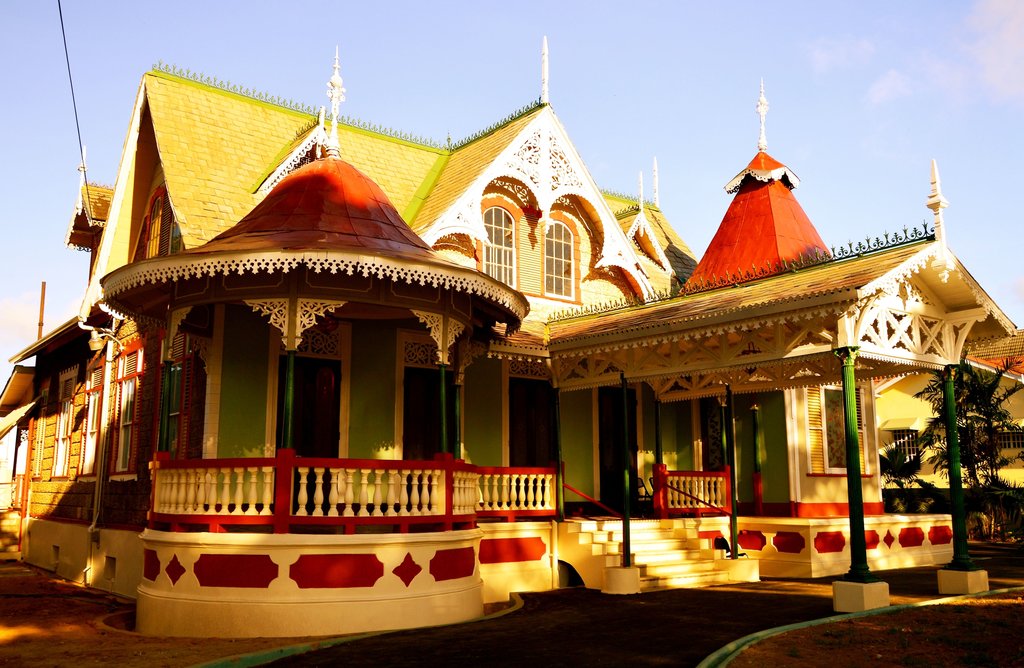|
Laventille teen gets into US Ivy League university
Every year Princeton University in New Jersey, USA, receives around 35,000 applications for entry. Fewer than 2,000 applicants are admitted, making the private Ivy League institution one of the most difficult schools to get into. But not only was 19-year-old Laventille resident Jafar Howe accepted into Princeton, but he also got accepted into Dartmouth College, another Ivy League school in the USA. He grew up in Quarry Street, Laventille. Howe told the Express when he sent out the applications he was not optimistic. He had narrowly missed out on a Government scholarship despite performing well in the Caribbean Advanced Proficiency (CAPE) exams.
0 Comments
 Giselle and Halle were best friends at the Miss World 1986 contest. Halle represented the United States and placed 6th; Giselle won the contest. Miss World 1986, Giselle Laronde turned down movie contracts provided by the Miss World Organisation as she wanted to focus on her education in London. Part of the winner's package was a scholarship to any top university in the UK. Giselle asked the MWO to grant Halle Berry the movie contracts and the opportunity to travel with her around the world. Well, the rest is history... Today, they maintain a great friendship  Tobago’s Main Ridge Forest Reserve has been named the Caribbean Nature Park of the Year in the Caribbean Journal’s Caribbean Awards 2019. Caribbean Journal (CJ) is the world’s largest website covering the Caribbean, has original content and video focusing on travel and tourism across the entire Caribbean and is the global leader in covering Caribbean travel and trade news. According to the Journal, the Green Awards are meant to “celebrate those who are already working to protect and strengthen this beautiful corner of the world.” In the article posted on their website, Caribbean Journal emphasised that being “green” encompasses renewable energy, local and sustainable tourism, and consideration of the environment. Tobago’s Main Ridge Forest Reserve, which was recognised by Caribbean Journal as the Caribbean Nature Park of the Year, was declared a Crown Reserve in 1776 making it the oldest legally protected forest reserve in the Western Hemisphere established for a conservation purpose. It was also nominated as a UNESCO World Heritage Site in August 2011, and was voted the “World’s Leading Eco-Tourism destination” by the World Travel Awards in 2003, 2004, 2005 and 2006. The Caribbean Journal described the Reserve as “a living example of the power of conservation and one whose continued stewardship sends a daily message to the rest of the region. It’s also one of the most remarkable places to visit in the region, a haven of biodiversity and a portal into the natural splendor of this gem of the Southern Caribbean.” The Main Ridge Forest Reserve is one of the island’s attractions that form part of its thriving eco-tourism product—one of the four pillars for growth of the tourism industry identified by the Tobago Tourism Agency. Visitors to the reserve can enjoy its lush tropical beauty through guided tours, nature walks, bird watching and mountain biking. Source: CNC3  Over 90 Venezuelan passengers trying to get into TT through the Cedros port were turned back by T&T Coast Guard as patrols on the border heightened on Thursday. With intensified street protests and violent clashes on the streets of Venezuela, hundreds of desperate Venezuelans have found the fresh resolve to flee their homeland. A source who requested anonymity said two ferries Orinoco Delta and Angel were scheduled to arrive at the Cedros port on Thursday. The Orinoco Delta was transporting 60 passengers, including one Trinidadian man with his passport. The Angel had 35 passengers which included two Venezuelan women who are married to Trinidadian men and an elderly Venezuelan woman. She had a Trinidadian passport and was accompanied by a child believed to be her grandson. The source said upon reaching about two miles off the Cedros coast, the TT Coast Guard interceptor stopped the Angel. They detained the passengers at sea for more than an hour, perusing documents. All of the Venezuelans were sent back except the grandmother and the two women with Trinidadian husbands. The grandmother was distraught that the grandson was separated from her, the source added. The Angel had been registered to dock at the Cedros port, the source added. The Orinoco Delta which normally comes to Cedros port at least three times per week was also stopped by the Coast Guard. For more than an hour, the vessel stayed out at sea. The lone Trinidadian was taken back to the port via the Coast Guard vessel but after an hour of detention, the ferry with almost 60 passengers was also sent back by the TTCG. "No instructions were given to Customs and officers were later briefed. It is not usual for the ferries to be sent back because Venezuelans come here to shop for basic groceries and medicine to take back to their families, " the source added. At the Cedros coast, dozens of people waited for the ferries to dock up to 430 pm. It was through WhatsApp that some of them learned the TTCG had detained the ferries. One man who took videos of the Coast Guard was warned by CG officers who threatened to arrest him if he failed to delete the video. Contacted for comment, councilor for Cedros Shankar Teelucksingh said he was puzzled by the developments. He said the TTCG should have informed the ferry owners that they were not allowed to enter the Cedros port prior to their departure in Venezuela. Teelucksingh said the TTCG should focus on cracking down on the illegal entry of Venezuelans. "This kind of thing will cause Venezuelans to choose the illegal way to enter rather than the legal way" he added. Teelucksingh also said better lockdown of the borders were needed for those boats bringing in illegal migrants. Contacted for comment yesterday Public Affairs Lieutenant of the TT Coast Guard Officer Hillaire said a statement will be issued pending investigations. Since tensions escalated in Venezuelan in January, hundreds of Venezuelans have been entering TT through several points in the southern coast. These include Galfa Point, Carlise Trace, Coromandel, Chatham, Green Hill, Icacos, Columbus Bay and Fullarton Beach. The foreigners are dropped off on the beach. They hide out in the forests at nights and by 5 am they are picked up in maxi taxis by Trinidadian men. Venezuelans normally spend between $1,500 to $2,000 to get to Trinidad. The fees are paid in US and are non-refundable. It is estimated that there are between 40,000 to 50,000 Venezuelans living illegally in TT. An estimated 700 Venezuelans come through the Cedros port weekly. Source: CNC3 The National Trust of Trinidad and Tobago recognized the restoration work on Boissiere House with an award in 2014.CreditCreditLiam Boodoo PORT OF SPAIN, Trinidad — After languishing for more than five years on the international real estate market, Boissiere House, a much-photographed dwelling also known as the Gingerbread House, has finally been bought and restored, and its owners have received a heritage award for the work done on the project.
The house was built in 1904 on the edge of the green space known as Queen’s Park Savannah by C.E.H. Boissière, a prominent businessman, and was long the home of mixed-race descendants of French merchants and plantation owners. In 2013 it was purchased by the Sammy family, wealthy Indo-Trinidadians who made their fortune in the island’s booming construction industry. The family patriarch, Junior Elgin Sammy, bought the house as a gift to himself for his 61st birthday. The Sammys took ownership in November 2013, and the renovation work began immediately, said Shivonne Sammy Maharaj, Mr. Sammy’s daughter. “We basically bought a dilapidated, broken shell and aimed to restore its magnificence,” Ms. Sammy Maharaj said in an email. “Our main challenge in the restoration would be to not break anything, not change anything and of course to not offend anyone with our decisions.” Though the Sammys declined to say how much they paid for the house, three years ago the asking price was 20 million Trinidadian dollars, or about $3.15 million. The work on the 3,500-square-foot house was carried out under the oversight of the heritage architect Rudylynn De Four Roberts, and was accomplished so effectively that the National Trust of Trinidad and Tobago recognized the project with a historic restoration award in 2014. The decision by Mr. Sammy to buy and renovate the house was a rare one on an island with little tradition of preserving its built heritage. Indeed, Ms. Roberts said buildings that are important to Trinidad and Tobago historically and culturally continue to be imperiled. She told the story of the Greyfriars Church of Scotland, a 19th-century building in Port of Spain that was bought last year by a businessman, who promptly moved to demolish it. The local group Citizens for Conservation, to which Ms. Roberts belongs, intervened and “was able to save that building,” she said. “Otherwise it would have come down.” For Mr. Sammy, the acquisition of Boissiere House was a childhood dream fulfilled. As Ms. Sammy Maharaj explained it, “as a young boy, my father would go for Sunday drives with his parents to Port of Spain, and always admired the historical majestic homes around the Queen’s Park Savannah. He imagined one day owning one of these homes, and as he grew his ambition of this never changed.” She said that the restoration of the house had been a family project involving her mother, Linda, her husband, Rajendra Maharaj, and all of her siblings, and that her father has asked his children to keep the house in the family as part of his legacy. Ms. Roberts said that although work still needed to be done on some aspects of the house, such as the fretwork on the roof that would require specialist joiners, “enough work was done to prevent and to halt further deterioration.” The house, which Ms. Roberts described as Arts and Crafts in style, with elements of West Indian vernacular architecture, is made of wood and stone. It has four bedrooms and two bathrooms, living and dining areas, a study and both indoor and outdoor kitchens. It also has a wraparound veranda, a classic of West Indian style, whose original mosaic pattern tiles of brown, cream and green have been retained. Other vernacular elements include Demerara and sash windows, and ornate fretwork above all the doors for ventilation. A dormer window that was meant to keep the attic timbers dry likewise enhances ventilation. The steep, pitched gable roof is decorated extensively with finials. The interior is painted in cream, with dark wood wainscoting and floors of polished cedar. Where the tops of the walls meet the ceilings there are cornice moldings, and a fancy chandelier in the living room hangs from a ceiling rose. In decorating the house, Ms. Sammy Maharaj said, “We wanted to relive the era of the house,” but “still needed it to be comfortable and livable.” Keeping that dual objective in mind, they have furnished the house with pieces collected from antiques shops in the United States and Britain, as well as some of her grandparents’ furniture. Originally published on March 26, 205 by Jewel Fraser, New York Times. |
T&T news blogThe intent of this blog is to bring some news from home and other fun items. If you enjoy what you read, please leave us a comment.. Archives
July 2025
Categories
All
|



 RSS Feed
RSS Feed